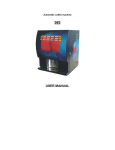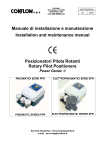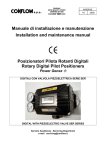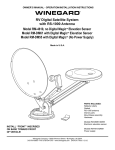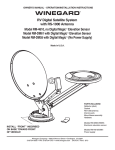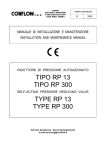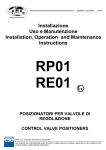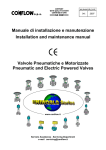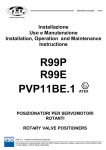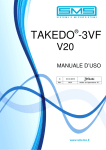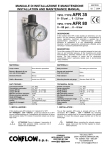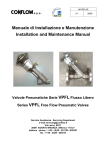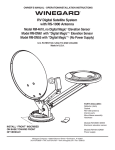Download Manuale
Transcript
M/PPL/EPL/I/E 03 2005 Manuale di installazione e manutenzione Installation and maintenance manual Posizionatori Pilota Lineari Linear Pilot Positioners Power Genex PNEUMATICI SERIE PPL ELETTROPNEUMATICI SERIE EPL PNEUMATIC SERIES PPL ELECTROPNEUMATIC SERIES EPL Servizio Assistenza - Servicing Department e-mail [email protected] INDICE INDEX Pag. Page 1 DESCRIZIONE 1 1 DESCRIPTION 1 2 DATI TECNICI TIPO PPL 1 2 TECHNICAL DATA type PPL 1 3 DATI TECNICI TIPO EPL 1 3 TECHNICAL DATA type EPL 1 4 INFORMAZIONI SICUREZZA GENERAL AND SAFETY INFORMATION 1 5 POSITIONER–ACTUATOR COUPLING 2 5.1 ACCOPPIAMENTO POSIZIONATORE ATTUATORE Funzionamento ad azione diretta 2 5.1 Direct acting operation 2 5.2 Funzionamento ad azione rovescia 2 5.2 Reverse acting operation 2 6 INSTALLAZIONE SU VALVOLA 3 6 INSTALLATION ON VALVE 3 6.1 Montaggio su valvola con attuatore a castello integrale (IEC 534) 3 6.1 Fitting the positioner to yoke tipe actuator (IEC 534) 3 6.1.1 Posizionatore in fronte 3 6.1.1 Positioner in front 3 6.1.2 Posizionatore sul retro Montaggio su valvola con attuatore a colonna (IEC 534) 4 4 5 6.1.2 Positioner on the back side Fitting the positioner to pillar type actuator 6.2 6.2.1 Posizionatore in fronte 5 6.2.1 Positioner in front 5 6.2.2 Posizionatore sul retro 6 6.2.2 Positioner on the back side 6 7 MONTAGGIO ATTUATORE 7.1 Blocchetto IEC 534 8 CONNESSIONI ELETTRICHE 9 AVVIAMENTO 10 OPERAZIONE AUTO - MANUALE 11 REGOLAZIONE VELOCITA’ VALVOLA 11.1 Manutenzione valvola pilota 12 SPLIT - RANGE 13 14 6.2 GENERALI SU ALTRI DI TIPI DI 1 2 4 5 5 7 INSTALLATION ON DIFFERENT TYPE OF ACTUATORS 7 7.1 Block IEC 534 7 8 PNEUMATIC CONNECTIONS 9 9 START-UP 9 9 10 AUTO – MANUAL OPERATION 9 11 OPTIONAL RESTRICTED PILOT VALVE ORIFICES 10 10 11.1 Pilot valve maintenance 10 11 12 SPLIT - RANGE 11 ANOMALIE DI FUNZIONAMENTO 12 13 TROUBLES SHOOTING 12 RICAMBI 13 14 SPARE PARTS 13 7 7 PNEUMATICHE ED 8 10 AND ELECTRIC 8 1 – DESCRIZIONE 1 – DESCRIPTION PPL e EPL sono posizionatori a semplice e doppio effetto con segnale in entrata 3-15 psi e 4-20 mA per il controllo proporzionale di attuatori lineari. Gli apparecchi confrontano il segnale proveniente dall’unità regolante con la posizione della leva di feedback collegata allo stelo dell’otturatore. La comparazione tra queste due forze genera una pressione di uscita che agisce direttamente sulla membrana dell’attuatore. PPL and EPL are simple or double acting positioner with input signal 3-15 psi and 4-20 mA for proportional control of pneumatic linear actuators. The positioners operate by comparision of the signal, coming from the control unit, with the position of feedback lever joined to the valves stem. An amplified pressure, generates by the comparision of these two forces, operates directly on actuator diaphragm. 2- DATI TECNICI tipo PPL : 2- TECHINICAL DATA type PPL : Protezione Segnale di Ingresso Split range Alimentazione Aria Corsa Nominale Connessioni Pneumatiche Temperatura Ambiente Linearità Sensibilità Isteresi Ripetibilità Consumo d’aria Capacità Peso Waterproof IP 66 3 - 15 psi … 0.2 – 1.0 bar Disponibile 1.4 … 7 bar (20 … 100 psi) 10 … 80 mm Unica molla 1/4” NPT -20 ° … +80 °C Entro +/- 1.0 % fondo scala Entro 0.2 % fondo scala Entro 0.5 % fondo scala Entro +/- 0.5 % fondo scala 5 LPM (supply 1.4 bar) 80 LPM (supply 1.4 bar) 2.1 Kg Protection Input Signal Split range Supply Air Pressure Standard stroke Connessioni pneumatiche Ambient Temperature Linearity Sensitivity Hysteresis Repeatibility Air consumption Flow capacity Weight 3 - DATI TECNICI tipo EPL : TIPO EPL Tipo EPL-EX Segnale di Ingresso Impedenza entrata Split range Alimentazione Aria Corsa Nominale Connessioni Pneumatiche Connessioni Elettriche Temperatura Ambiente Linearità Sensibilità Isteresi Ripetibilità Consumo d’aria Capacità Peso EPL Peso EPL-EX Waterproof IP 66 3 - 15 psi … 0.2 – 1.0 bar Available 1.4 … 7 bar (20 … 100 psi) 10 … 80 mm Unic spring 1/4” NPT -20 ° … +80 °C Within +/- 1.0 % F.S. Within 0.2 % F.S. Within 0.5 % F.S. Within +/- 0.5 % F.S. 5 LPM (supply 1.4 bar) 80 LPM (supply 1.4 bar) 2.1 Kg 3- TECHINICAL DATA type EPL : Waterproof IP 66 Flameproof – Exmd IIB T6 Sicurezza Intrinseca – Exia IIB T6 4 – 20 mA Ui ≤ 30 V li ≤ 150 mA Pi ≤ 0,80 W 235 +/- 15 Ω Disponibile 1.4 … 7 bar (20 … 100 psi) 10 … 80 mm Unica molla ¼” NPT PG16 su attacco ½” NPT -20 ° … +70 °C Entro +/- 1.0 % fondo scala Entro 0.2 % fondo scala Entro 0.5 % fondo scala Entro +/- 0.5 % fondo scala 5 LPM (supply 1.4 bar) 80 LPM (spply 1.4 bar) 2.1 Kg 2.9 Kg Type EPL Type EPL-EX Input Signal Input resistance impedance Split range Supply Air Pressure Standard stroke Connessioni pneumatiche Electric Connections Ambient Temperature Linearity Sensitivity Hysteresis Repeatibility Air consumption Flow capacity Weight EPL Weight EPL-EX Waterproof IP 66 Flameproof – Exmd IIB T6 Intrinsic Safety – Exia IIB T6 4–20 mA Ui ≤ 30 V li ≤ 150 mA Pi ≤ 0,80 W 235 +/- 15 Ω Available 1.4 … 7 bar (20 … 100 psi) 10 … 80 mm Unic spring ¼” NPT PG16 on connection ½” NPT -20 ° … +70 °C Within +/- 1.0 % F.S. Within 0.2 % F.S. Within 0.5 % F.S. Within +/- 0.5 % F.S. 5 LPM (supply 1.4 bar) 80 LPM (supply 1.4 bar) 2.1 Kg 2.9 Kg 4 – INFORMAZIONI GENERALI DI SICUREZZA 4 – GENERAL AND SAFETY INFORMATIONS Prima di installare gli apparecchi rimuovere le protezioni di plastica poste a copertura degli attacchi di connessione. ATTENZIONE Durante il funzionamento gli apparecchi contengono pressione d’aria. ATTENZIONE Durante l’esercizio non toccare lo stelo perché é in movimento, potrebbe intrappolare le dita o i vestiti. ATTENZIONE Prima di iniziare eventuali operazioni di manutenzione assicurarsi che il posizionatore non sia in pressione . ATTENZIONE I posizionatori EPL-EX (sicurezza intrinseca – flameproof) devono essere alimentati da costruzioni elettriche associate, certificate in conformità alle norme EN 50.014 ed EN 50.020 che rispettino i limiti delle caratteristiche elettriche vedi punto 3. Before installing positioner, remove plastic covers placed on connection ends. WARNING Be careful during functioning the positioners are under air pressure. WARNING Be careful not to touch the stem, whilst it’s in operation, as this is moving, it’s possible trapping of fingers and clothes. WARNING Before starting maintenance be sure that the positioner is not pressurized . La mancata osservanza delle informazioni generali di sicurezza, delle norme vigenti e delle istruzioni di montaggio possono: In the event of non-observance of the general rules, safety informations and of the installation instructions, this may: ! • • ! WARNING The positioners type EPL-EX (intrinsic safety – flameproof) must be feed by electric devices certified in conformity with EN 50.014 and EN 50.020 standards. The devices must comply the electric features mentioned on technical specification, see point 3. • • Causare pericolo per l’incolumità di chi sta eseguendo le manovre o di terzi Compromettere l’efficiente funzionamento del posizionatore 1 Cause danger to life and limb of the user or third party Endanger the efficient functioning of the positioner 6 - INSTALLAZIONE SU VALVOLA 6- INSTALLATION ON VALVE 6.1 MONTAGGIO SU VALVOLA CON ATTUATORE A CASTELLO INTEGRALE ( IEC 534 ) 6.1 FITTING THE POSITIONER TO YOKE TYPE ACTUATOR ( IEC 534 ) 6.1.1 – POSIZIONATORE IN FRONTE Montare il posizionatore come indicato nella fig. 1 6.1.1 – POSITIONER IN FRONT Mount the positioner as showed on fig.1 STAFFA POSIZIONATORE Rif.3 Positioner mounting bracket Fig.1 TARGHETTA INDICE DI CORSA Travel indicator label STAFFA VALVOLA Rif.1 Valve stem joint PERNO LEVA Rif.2 Pin lever VITE DI SERRAGGIO Rif.4 STAFFA POSIZIONATORE Positioner mounting bracket locknut LEVA SPAN Vedi schema in basso SPAN LEVER See below 100% LEVA SPAN VERSO IL BASSO VALVOLA AR SPAN LEVER IN LOWER POSITION AR VALVE 0 0 VALVOLA AD AD VALVE 100% LEVA SPAN VERSO L’ALTO SPAN LEVER IN UPPER POSITION Fissare la staffa Rif.1 allo stelo, appena sotto il disco indicatore, serrandola con i due dadi. Fissare il perno leva Rif.2 alla leva del posizionatore per mezzo dei dadi in dotazione (posizione centrale). Fissare il posizionatore alla staffa posiz. Rif.3 e serrare provvisoriamente la vite Rif.4. Dare aria all’attuatore fino a raggiungere meta’ corsa; quando la leva è in posizione orizzontale bloccare definitivamente la vite Rif.4 quindi togliere l’aria dall’attuatore. Place the valve stem joint Ref.1 to the stem valve, just below the indicator disc, and screw it with the two nuts. Place the pin lever Ref.2 to the positioner lever with the nuts included (middle position). Place the positioner to the mounting bracket Ref.3 and hand tighten the locknut Ref.4. Supply air to the actuator up to half stroke. When the lever is horizontal, screw definitively the locknut Ref.4 and take off the air from the actuator. 3 6 - INSTALLAZIONE SU VALVOLA 6- INSTALLATION ON VALVE 6.1 MONTAGGIO SU VALVOLA CON ATTUATORE A CASTELLO INTEGRALE ( IEC 534 ) 6.1 FITTING THE POSITIONER TO YOKE TYPE ACTUATOR ( IEC 534 ) 6.1.2 – POSIZIONATORE SUL RETRO Montare il posizionatore come indicato nella fig. 2 6.1.2 – POSITIONER ON THE BACK SIDE Mount the positioner as showed on fig.2 TARGHETTA INDICE DI CORSA (sul lato posteriore) Travel indicator label (on the back side) Fig.2 VITE DI SERRAGGIO STAFFA POSIZIONATORE Rif.4 Positioner mounting bracket locknut STAFFA VALVOLA Rif.1 Valve stem joint PERNO LEVA Rif.2 Pin lever LEVA SPAN Vedi schema in basso STAFFA POSIZIONATORE Rif.3 Positioner mounting bracket 100% SPAN LEVER See below LEVA SPAN VERSO IL BASSO VALVOLA AR SPAN LEVER IN LOWER POSITION AR VALVE 0 0 VALVOLA AD AD VALVE 100% LEVA SPAN VERSO L’ALTO SPAN LEVER IN UPPER POSITION Fissare la staffa Rif.1 allo stelo, appena sotto il disco indicatore, serrandola con i due dadi. Fissare il perno leva Rif.2 alla leva del posizionatore per mezzo dei dadi in dotazione (posizione centrale). Fissare il posizionatore alla staffa posiz. Rif.3 e serrare provvisoriamente la vite Rif.4. Dare aria all’attuatore fino a raggiungere meta’ corsa; quando la leva è in posizione orizzontale bloccare definitivamente la vite Rif.4 quindi togliere l’aria dall’attuatore. Place the valve stem joint Ref.1 to the stem valve, just below the indicator disc, and screw it with the two nuts. Place the pin lever Ref.2 to the positioner lever with the nuts included (middle position). Place the positioner to the mounting bracket Ref.3 and hand tighten the locknut Ref.4. Supply air to the actuator up to half stroke. When the lever is horizontal, screw definitively the locknut Ref.4 and take off the air from the actuator. 4 6 - INSTALLAZIONE SU VALVOLA 6- INSTALLATION ON VALVE 6.2 MONTAGGIO SU VALVOLA CON ATTUATORE A COLONNA ( IEC 534 ) 6.2 FITTING THE POSITIONER TO PILLAR TYPE ACTUATOR ( IEC 534 ) 6.2.1 – POSIZIONATORE IN FRONTE Montare il posizionatore come indicato nella fig. 3 6.2.1 – POSITIONER IN FRONT Mount the positioner as showed on fig.3 Fig.3 ARCHETTI FISSAGGIO COLONNA Rif.4 Pillars yoke STAFFA VALVOLA Rif.1 Valve stem joint PERNO LEVA Rif.2 Pin lever STAFFA POSIZIONATORE Rif.3 Positioner mounting bracket LEVA SPAN Vedi schema in basso SPAN LEVER See below 100% LEVA SPAN VERSO IL BASSO VALVOLA AR SPAN LEVER IN LOWER POSITION AR VALVE 0 0 VALVOLA AD AD VALVE 100% LEVA SPAN VERSO L’ALTO SPAN LEVER IN UPPER POSITION Fissare la staffa Rif.1 allo stelo, appena sotto il disco indicatore, serrandolo con i due dadi. Fissare il perno leva Rif.2 alla leva del posizionatore per mezzo dei due dadi in dotazione (posizione centrale). Fissare il posizionatore alla staffa posiz. Rif.3 e serrare provvisoriamente i dadi degli archetti Rif.4. Dare aria all’attuatore fino a raggiungere metà corsa; quando la leva è in posizione orizzontale bloccare definitivamente i dadi degli archetti Rif.4 quindi togliere l’aria dall’attuatore. Place the valve stem joint Ref.1 to the stem valve, just below the indicator disc, and screw it with the two nuts. Place the pin lever Ref.2 to the positioner lever with the nuts included (middle position). Place the positioner to the mounting bracket Ref.3 and hand tighten the pillars yoke locknuts Ref.4. Supply air to the actuator up to half stroke. When the lever is horizontal, screw definitively the pillars yoke locknuts Ref.4 and take off the air from the actuator. 5 6 - INSTALLAZIONE SU VALVOLA 6- INSTALLATION ON VALVE 6.2 MONTAGGIO SU VALVOLA CON ATTUATORE CON CASTELLO A COLONNE ( IEC 534 ) 6.2 FITTING THE POSITIONER TO PILLAR TYPE ACTUATOR ( IEC 534 ) 6.2.2 – POSIZIONATORE SUL RETRO Montare il posizionatore come indicato nella fig. 4 6.2.2 – POSITIONER ON THE BACK SIDE Mount the positioner as showed on fig.4 Fig.4 STAFFA VALVOLA Rif.1 Valve stem joint ARCHETTI FISSAGGIO COLONNA Rif.4 Pillars yoke PERNO LEVA Rif.2 Pin lever STAFFA POSIZIONATORE Rif.3 Positioner mounting bracket 100% LEVA SPAN Vedi schema in basso SPAN LEVER See below LEVA SPAN VERSO IL BASSO VALVOLA AR SPAN LEVER IN LOWER POSITION AR VALVE 0 0 VALVOLA AD AD VALVE 100% LEVA SPAN VERSO L’ALTO SPAN LEVER IN UPPER POSITION Fissare la staffa Rif.1 allo stelo, appena sotto il disco indicatore, serrandolo con i due dadi. Fissare il perno leva Rif.2 alla leva del posizionatore per mezzo dei due dadi in dotazione (posizione centrale). Fissare il posizionatore alla staffa posiz. Rif.3 e serrare provvisoriamente i dadi degli archetti Rif.4. Dare aria all’attuatore fino a raggiungere metà corsa; quando la leva è in posizione orizzontale bloccare definitivamente i dadi degli archetti Rif.4 quindi togliere l’aria dall’attuatore. Place the valve stem joint Ref.1 to the stem valve, just below the indicator disc, and screw it with the two nuts. Place the pin lever Ref.2 to the positioner lever with the nuts included (middle position). Place the positioner to the mounting bracket Ref.3 and hand tighten the pillars yoke locknuts Ref.4. Supply air to the actuator up to half stroke. When the lever is horizontal, screw definitively the pillars yoke locknuts Ref.4 and take off the air from the actuator. 6 7 - MONTAGGIO SU ALTRI TIPI DI ATTUATORE 7- INSTALLATION ON DIFFERENT TYPE OF ACTUATORS I Posizionatori PPL e EPL possono essere montati anche su attuatori con castello piatto con due soluzioni : EPL and PPL positioners can be also mounted on flat yoke actuators with the following solutions: ¾ Praticando due fori Ø 8,5 opp. Ø 9 mm sul castello e sfruttando i due fori M8 presenti sui posizionatori come indicato nella Fig.5 ¾ Praticando due fori M8 sul castello e sfruttando la staffa in dotazione come mostrato nella Fig. 6 ¾ Drilling two holes Ø 8.5 or Ø 9 mm on yoke valve and using the two positioner holes screw M8 as showed on Fig.5 ¾ Drilling two holes M8 on yoke valve and using the positioner bracket included as showed on Fig.6 Fig.5 Fig.6 7.1 BLOCCHETTO IEC 534 Per le valvole con blocchetto a norme IEC 534 sullo stelo richiedere la staffa apposita ( Optional con extraprezzo ) vedi Fig. 7 7.1 BLOCK IEC 534 For valves with IEC 534 Block on the stem, ask for the suitable bracket ( optional with extraprice), see Fig.7 Fig.7 7 8 - CONNESSIONI PNEUMATICHE ED ELETTRICHE 8- PNEUMATIC AND ELECTRIC CONNECTIONS Tutti i collegamenti pneumatici sono facilmente accessibili vedi Fig.7. Per le connessioni elettriche serie EPL inserire i due fili nel passacavo e collegarli alla morsettiera interna contrassegnata con “+” e “-“ vedi Fig. 8. All pneumatic connections are easily accessible, see Fig.7. For the electric connections EPL type, put the two cables into the cable gland and plug them to the internal terminal board marked by “+” and “-“, see fig. 8 ATTENZIONE I posizionatori EPL-EX (sicurezza intrinseca – flameproof) devono essere alimentati da costruzioni elettriche associate, certificate in conformità alle norme EN 50.014 ed EN 50.020 che rispettino i limiti delle caratteristiche elettriche indicate nel punto 3. WARNING The positioners type EPL-EX (intrinsic safety – flameproof) must be feed by electric devices certified in conformity with EN 50.014 and EN 50.020 standards. The devices must comply the electric features mentioned on technical specification, see point 3. ! ! Fig.7 TIPO/TYPE PPL Fig.8 TIPO/TYPE EPL SCHEMA ELETTRICO WIRE DIAGRAMS 8 9 - AVVIAMENTO 9 - START-UP ¾ Controllare che tutti i collegamenti siano corretti e che il posizionatore sia montato secondo la funzione richiesta ( vedi sez. 5 ) ¾ Check that all pneumatic and electrical connections are correct and the positioner is mounted according to the function required ( refer to section 5) ¾ Fornire l’alimentazione al posizionatore : 30 psi per le valvole di regolazione 6 / 7 bar per valvole a pistone ¾ Supply air to the positioner : 30 psi for control valves 6 / 7 bar for valve with piston ¾ Fornire il segnale di comando 3 psi o 4 mA. Girare la rotella dello zero in senso orario o antiorario fino ad ottenere la partenza della valvola vedi Fig. 9 ¾ Supply the input signal 3 psi or 4 mA. Turn the zero adjusting screw clockwise or counter clockwise to set the zero position. ¾ Controllare la corsa della valvola fornendo il segnale max di 15 psi o 20 mA. Se la corsa non raggiunge il 100 % svitare o avvitare la vite dello SPAN fino a raggiungere il 100% vedi Fig.9. ¾ Check the stroke of the control valve by setting input signal 15 psi or 20 mA. If the stroke does not meet 100%, turn the span adjusting screw clockwise or counter clockwise until 100% is reached., the same operation is necessary if the positioner reached the 100% before with max signal ¾ Controllare nuovamente lo zero ¾ Check again the zero position Rotella dello Zero Fig. 9 Zero adjusting screw Vite dello SPAN SPAN adjusting screw Dettaglio “A” AUTO-MANUALE Vedi punto 10 “A” detail AUTO-MANUAL See point 10 10 - OPERAZIONE AUTO - MANUALE 10 – AUTO-MANUAL OPERATION Per operare manualmente usare un filtro riduttore e posizionare la vite Auto – Manuale presente nel pilota in posizione M. (Vedi dettaglio “A” sotto). Questa operazione permette di bypassare il segnale di ingresso 3-15 psi. For manual operation using an external air regulator, set the Auto / Manual switch located on the pilot valve to M ( see detail “A” below). This will bypass the 3-15 psi input signal. Vite Auto – Manuale Auto – Manual Screw Alloggiamento sede Seat Adjuster ! Dettaglio “A” Da non muovere Don’t touch Vite di bloccaggio Stopper screw “A” detail 9 11 - REGOLAZIONE VELOCITA’ VALVOLA ! ATTENZIONE assicurarsi di alimentazione Nel caso il posizionatore risulti troppo veloce, viene fornito, insieme al posizionatore, un kit di orifizi a passaggio ridotto. Per installarlo, occorre rimuovere dal posizionatore il pilota: • • • • • 11 – OPTIONAL RESTRICTED PILOT VALVE ORIFICES Prima di rimuovere il pilota, avere scollegato segnale ed Svitare le quattro viti “A” (Vedi Fig. 10) di fissaggio Togliere la molla di compensazione “B” (vedi Fig.10) Una volta rimosso il pilota, ruotarlo sottosopra (vedi Fig.11) Rimuovere gli O-rings dalle porte Out1 e Out2 (vedi Fig 11) Posizionare i piattelli degli orifizi nelle rispettive sedi e porre sopra di essi i nuovi O-rings, quindi rimontare il pilota ! WARNING Before removing pilot valve, be sure to disconnect positioner from the signal and supply air. In case the positioner is too fast, is included with the positioner a restricted pilot valve orifice kit. To install it, the pilot valve must be removed from the positioner: • • • • • Remove the four screws “ A” (see Fig.10) holding the pilot to the positioner body. Remove the compensation spring “B” (see Fig.10) When the pilot is removed, reverse it as showed on Fig.11 Remove the o-rings from Out 1 and Out 2 ports as showed on Fig.11 Place the orifices plates in their places with the new o-rings above them and re-install the pilot valve 11.1 MANUTENZIONE VALVOLA PILOTA 11.1 PILOT VALVE MAINTENANCE Nel caso sia necessario sostituire la valvola pilota a seguito di usura, operare come sopra. In case of a replacement of the pilot valve due to wear, follow the istructions above. Fig.10 B A A Fig. 11 OUT 1 OUT 2 10 12 - SPLIT-RANGE 12 – SPLIT RANGE Se l’applicazione lo richiede è possibile eseguire il 100% di corsa con il segnale in ingresso ridotto del 50 % esempio : ¾ ¾ Serie PPL 3-9 psi … 9-15 psi Serie EPL 4-12 mA … 12- 20 mA ¾ ¾ Per ottenere questo funzionamento è necessario effettuare in opzione le seguenti regolazioni : 1. 2. 3. If required, 100% of stroke can be obtained with 50% reduced imput signal. Regolare il perno sulla leva di feedback vedi fig.12 dettaglio A Regolare la vite dello SPAN lever vedi fig. 12 dettaglio B Spostare il posizionatore sulla staffa vedi fig. 12 dettaglio C (operazione consigliata solo per corse superiori a 30 mm) Una volta raggiunto il campo desiderato procedere come al punto 9. PPL series 3-9 psi … 9-15 psi EPL series 4-12 mA … 12- 20 mA To obtain this function it is necessary to make the following set-up: 1. 2. 3. Move the pin on feedback lever (see Fig.12, detail A) Turn the screw span lever (see Fig.12, detail B) Move the positioner on the bracket (see Fig.12, detail C) (Operation suggested only for stroke upper 30 mm) When the right span chapter 9. Fig.12 DETTAGLIO B DETAIL B DETTAGLIO A DETAIL A DETTAGLIO C DETAIL C 11 is obtained, follow the istructions in the 13 - ANOMALIE DI FUNZIONAMENTO Riportiamo qui di seguito alcuni inconvenienti che si possono verificare durante il funzionamento : INCONVENIENTI RISCONTRATI CAUSA PROVVEDIMENTO L’attuatore pendola e non si stabilizza Velocità troppo elevata Diminuire la velocità vedi punto 10 Vedi punto 8 fig. 7 Il posizionatore non regola correttamente apertura e chiusura dell’attuatore Connessioni pneumatiche non corrette Accoppiamento tra posizionatore e attuatore errato Collegamenti elettrici errati Mancanza del segnale di alimentazione Mancanza del segnale di comando Vedi punto 5 Vedi punto 8 fig.8 Controllare e sistemare Controllare e sistemare L’attuatore non compie il campo desiderato Regolazione del campo errata Vedi punto 9 L’attuatore non parte dalla posizione desiderata Regolazione dello zero errata Vedi punto 9 13 - TROUBLES SHOOTING Herebelow some of the possible causes giving troubles during normal working conditions : SYMPTOMS POSSIBLE CAUSE REMEDY Actuator hunting Opening/Closing speed too high Reduce the speed see chapter 10 See chapter 8 fig. 7 Positioner with wrong control action Wrong pneumatic connections Actuator and positioner coupling is not correct Wrong electric connections Supply air missing Control signal missing Actuator span inadeguate Span adjustment is wrong See chapter 9 Actuator start point shifted Zero adjustment is wrong See chapter 9 12 See chapter 5 See chapter 8 fig.8 Check and adjust Check and adjust 13 - RICAMBI 13 – SPARE PARTS VALVOLA PILOTA PILOT VALVE PPL SERIES MANOMETRO OUT 1 MANOMETER OUT 1 LEVA COMPLETA DI PERNO LEVER WITH PIN MANOM. ALIMENT. MAN. SUPPLY AIR MAN. SEGNALE MAN. INPUT LEVA DELLO SPAN SPAN LEVER STAFFA E VITI DI SERRAGGIO BRACKET WITH SCREWS STAFFA STELO VALVOLA VALVE STEM BRACKET EPL SERIES MANOM. ALIMENT. MAN. SUPPLY AIR LEVA COMPLETA DI PERNO LEVER WITH PIN LEVA DELLO SPAN SPAN LEVER VALVOLA PILOTA PILOT VALVE MANOMETRO OUT 1 MANOMETER OUT 1 STAFFA E VITI DI SERRAGGIO BRACKET WITH SCREWS 13 Servizio Assistenza - Servicing Department e-mail [email protected] Via Lecco, 69/71 20041 AGRATE BRIANZA (Milano) - ITALY telefono - phone : ++39 - (0)39 - 651705 / 650397 fax : ++39 - (0)39 - 654018





















